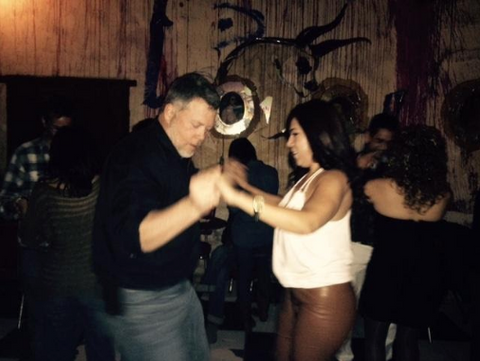Starting a Business From Scratch … Without Investors (From Prototypes To Production! … now it’s getting real)
(This is the story of Embrazio, a leather accessories company in Boulder, Colorado, complete with lessons learned and a few tools and exercises all brought together for your entertainment and hopefully a bit of learning to boot. The story is told in the form of a series of articles by Embrazio founders Scott Schaefer and Stephanie Boyles … who also happen to be married.)
Article #3 – From Prototypes To Production! … now it’s getting real
In Article #1 we took a quick look at the start of Embrazio, a leather accessories company founded by Stephanie Boyles and Scott Schaefer in Boulder, Colorado. The article highlighted that there really is no cookbook approach to starting and growing a company without outside investors and that the first thing to do is “get started!” We, Scott and Stephanie, made plenty of mistakes along the way that we hope readers of this series can avoid. One early mistake was not laying out a destination and general roadmap for getting there … also called a business plan and business case. That was the subject of article #2.
In this article, we turn back to the work of executing on the business itself. How do we get a production version of our product made and fully enter the competitive marketplace?
Lesson #3 – Navigating The Unknown

Early on, Embrazio successfully obtained a design patent for a curved custom leather belt that goes up and over your hips and down in back and front. Like many great designs, it seems logical and even simple once you see it. We can’t tell you how many times we’ve heard people say after discovering our belts, “hey, this looks just like the shape my belt has after I’ve been wearing it for 5 years.” The unique curved shape of the belt fits with the natural contours of the human form to avoid the pinch points and discomfort you get with traditional straight belts. It also eliminates that annoying gapping in the back that comes from putting a straight belt onto a curved body. We tested the comfort and fit using early handmade prototypes with friends and family around Boulder. The feedback we got was universally positive and very exciting. We thought we had a hit and wanted to rush to make the product.

Now, since neither of us knew a thing about the fashion industry, or much at all about manufacturing come to think of it, we immediately turned to the internet to answer the most urgent question in front of us, namely, “who in the hell can make this stuff at scale?”
Where To Make Curved Leather Belts?
We started, as we often do, with an internet search to figure out where to buy leather and who to use to fabricate our products. It was quickly evident that manufacturing in the US wasn’t really an option and our primary choices would be China, India, or Mexico. We did a back of the envelop matrix on the pros and cons of working with companies in these countries, had at least 2 glasses of wine, and decided we’d find a way to work with Mexico. Wish our decision making sounded a lot more scientific than that but we just couldn’t see crossing the pacific all the time and we love the Mexican people and culture. Turns out, this was a great decision and we’ve never looked back.

After some phone calls, we eventually found a company located in Leon, Mexico that was manufacturing great looking leather bags. We decided to give them a call to see if they could guide us to someone who could make our belts and cell phone holsters. Low and behold, they had just started making products for other labels and were interested in making our products. They quickly gave us a sales account rep. and we began working on specifications and contracts.

Boom, we had entered the rabbit hole of manufacturing in Mexico where relationships are everything, no yellow pages or internet directory exist, and the cultural differences were, for us, yet to be discovered. Our sales guy, Jerry, was an Irishman working for a Dutchman who managed an American owned factory in Leon staffed by Mexican workers and supervisors. We knew Steph’s years spent in endless international telecom standards meetings would one day pay off!

Thus began our education in all things leather under Jerry’s, and then Leticia’s, guidance (Jerry moved on after our first project). We traveled throughout Leon visiting leather tanneries, buckle making factories, and surplus markets. We met and started important relationships with some of Leticia’s other customers and we began to build our reputation in Leon as a fun, honest, and hard-working couple that doesn’t know much about leather but does listen carefully and follow up in a disciplined manner.

Growing Our Network
Our group of friends and contacts in Leon grew quickly and it was clear to us almost from day one that the rumor mill Jimmy Buffet calls “the coconut telegraph” is truly a broadband connection in that pretty big small town. There are some 2.5 million people living in and around Leon, Mexico and it is where 90% of leather goods sold in the US are produced. Still, word got around quickly that we understood specifications, were reasonable but demanding about expectations, and we paid our bills fast. That reputation led to more introductions and referrals and, ultimately, to the wonderful people and businesses in Leon we work with today.

Okay, we also did a little dancing, ate well, and had a bunch of fun along the way! But, back to our story …
In Mexico (and probably everywhere else) Reputation Is Everything!
What we had done right during this initial production phase was start what would become critical long-term business relationships that just kept multiplying. You see, it isn’t so much what you know or who you know but who knows you and what they are saying about you that matters most, especially when you’re operating in unfamiliar territory. We were, and still are, genuine in our relationships. We really do love and respect the people we work with. They feel that and return it ten-fold.

Hmmm, good job spending money…
We left those first few trips to Leon feeling that the production side of our business was well under way and our products were going to be fantastic. We’d paid close attention to our cash burn and we were starting to get a good sense for process, costs, quality control, styling, and other key elements. We’d done an initial business case (see article #2) but lots of the inputs and assumptions were still guesses and we were anxious about what reaction we’d get once our product was fully introduced to the market.

We were also still unclear about the best initial target market for our product or how to reach them via sales and marketing. New ideas for additional products were brewing and we were about to take possession of our first production run of leather accessories. The other thing we had yet to discover was how much cash actually gets tied up in inventory when you’re operating a consumer goods company.
No matter, momentum was growing and we were having fun so “damn the torpedoes & full speed ahead” we’re gonna make this work! If we’d have known our personal investment would need to be a lot bigger than our “best guess business case” suggested, we might have stopped right here. Instead, we both wrote checks for another $10k each and kept going.

Overall, we did a decent job of discovering where and how to get our products made but, to this point, most of our efforts involved spending money. We knew it was time to really zero in on how we would generate sales and revenue for the business. As my old mentor David had pounded into me so many years ago, “the problem is always sales Scott, everything else you can control.” We knew we were already late in really thinking through the Sales and Marketing aspects of our business which is where we’ll pick up in our next article; “The Problem Is Always Sales!” Hope you’ll stay tuned…
Summary of Lesson #3
- WE OFTEN START WITH THE INTERNET. We had no idea how to make leather accessories. We did know we’d need leather and someone to cut and sew the products. We thought we could manufacture in the US but quickly learned our choices were China, India, or Mexico. We chose Mexico mainly due to proximity and cultural fit once we learned their total cost to manufacture was competitive.
- NETWORK, NETWORK, NETWORK. The internet can only take you so far, especially when you’re relatively unfamiliar with an industry. You should quickly turn to expanding your network within an industry to start finding answers, and, almost as importantly, finding new questions (i.e., learning what you don’t know).
- RELATIONSHIPS MATTER. Relationships are built on trust and trust comes from living the golden rule. From day 1, you are creating, enhancing or destroying relationships within your business circle. You need to be honest and passionate about your business and the people you are working with if you expect them to be honest and passionate about working with you. How you work with people will open doors and create more opportunities … or leave you in the dark wondering why no one will return your calls.
General Checklist For Sourcing
-
Do you understand what your options are for partners?
Consider all of the places you might reasonably go to get your product made. In our case, we wanted to manufacture in the US but quickly found it wasn’t really a viable option. We then considered the next three major sources for leather accessories manufacture, China, India, and Mexico. Your options might be dramatically different if you’re building software or providing a service in combination with others. -
Have you determined the main criteria upon which to compare alternatives?
A primary element is obviously cost but there are other key variables as well. For example, consider cultural fit, time and cost of doing business beyond the cost of the product, and depth and stability of the industry within a country, etc.. We knew the time and cost of shipping relatively small amounts of product to/from China or India is much greater than Mexico. The time and cost of traveling to visit factories in Mexico was significantly less and the language and cultural differences were easier to overcome as well. -
How can you leverage this initial relationship?
Use this first relationship as a platform to meet other customers and providers within your industry. We can guarantee you’ll need additional partners/suppliers and you’ll likely meet them via your existing partner(s). -
Are you being a great partner?
It is so important to live the golden rule with everyone you meet. It will determine whether or not they introduce you to others that can help you along in your journey. Remember, it isn’t so much what you know or who you know but who knows you and what they are saying about you that matters most!
